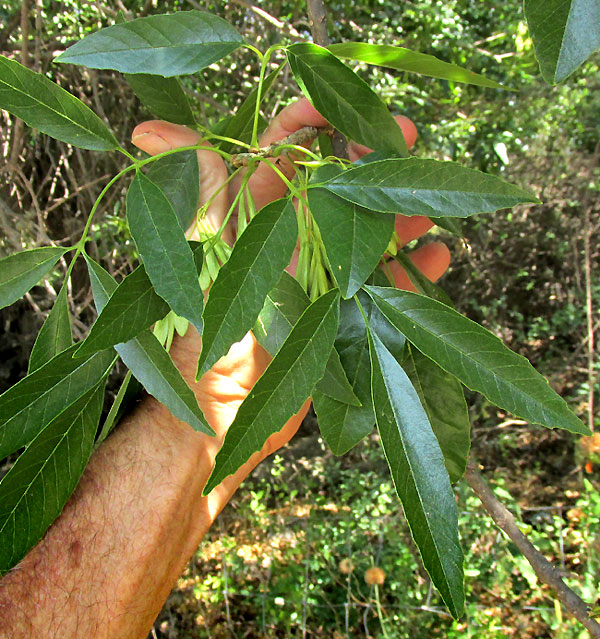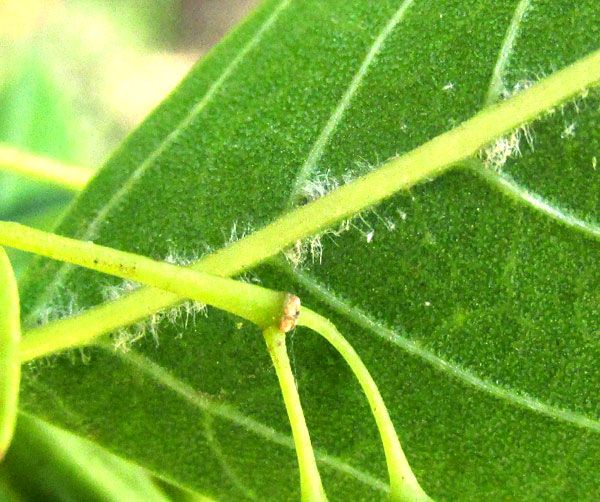Excerpts from Jim Conrad's
Naturalist Newsletter
entry dated May 21, 2022, notes from a camping trip among hills about 7kms ENE of Tequisquiapan, Querétaro state, MÉXICO
elevation about 2020m (6700 ft), near N20.57°, W99.85°
TROPICAL ASH TREE

Here at the end of an especially dry dry-season the landscape is mostly gray and brown, except in those rare spots at the bases of cliffs and the heads of canyons where spring water seeps to the surface. In such spots a small but lush and green oasis forms, where all through the day birds and other animals come to drink, and plant species turn up not found out in the sunbaked scrub. One of those species is a certain ash tree species, genus Fraxinus, its leaves and samara-type fruits shown above.
These ash trees are especially important in such oases because of the disproportionate abundance of shade and shelter from the dry wind they contribute to the oasis community. They are much larger than plants out in the scrub, and in our area this ash species and baldcypress trees are the only natural trees occurring in such oases. In this particular oasis there were no baldcypresses, and only this single ash tree.
A closer look at the ash's samara-type fruits, sometimes called "keys," is shown below:

A peculiarity of this species is that along the midrib of the tree's mostly hairless leaflets there are conspicuous white clumps of hairs, as seen below:

The trunk with its ashy color and narrow, vertical ridges of bark is typical of most ash species:

Worldwide about 43 ash species are recognized. In this part of semiarid upland central Mexico, four ash tree species are found, though three of those species form only woody shrubs or small trees. You can see from the above trunk that this is a good-size tree. Our oasis tree is the Tropical Ash, FRAXINUS UHDEI, capable of reaching 30m in height (100ft).
The Tropical Ash occurs in pine forest canyons and mountain slopes, and generally along streams, from northwestern Mexico south through Mexico and Central America to Costa Rica. It bears an English name because it's been introduced in many parts of the world's warmer areas, including California, Hawaii and India, not only as a street tree but for forestry and reforestation purposes. Often it escapes and becomes an invasive, competing with native plants.
Moreover, it's predicted that Tropical Ash will be planted and escape even more, since it's an attractive tree and its wood is very useful. It's a good source of short-fiber wood-pulp, and it's used in many kinds of light construction. It's useful for making plywood and particleboard, and is even durable enough to serve as tool handles, the making of sports equipment, and for wood carvings.
Whenever one sees an ash tree like this loaded with samara-type fruits, remembers that ashes are members of the olive family, and that olive trees produce juicy olive fruits, the question arises: How can one family produce such different kinds of fruits? Over the years many botanists have wondered that, but only with recent genetic sequencing has it become possible to gain real insight. In 2020, Julia Dupin and others published "Resolving the Phylogeny of the Olive Family (Oleaceae): Confronting Information from Organellar and Nuclear Genomes," in which they provided some answers.
First, as it is, the general configuration of the Olive Family, with its ±700 species in 28 genera, is fairly close to what the genes say, with only some tinkering needed at the lower levels. Second, the remarkable variability of species within the family "seems to be associated with polyploidisation events and the evolution of various reproductive and dispersal strategies."
Polyploidisation is the process by which cells in an organism somehow end up with more than the usual single one pair of chromosomes. Such mutations may hurt the resulting individual, or even kill it, but sometimes they may be beneficial and be passed on to offspring. It's estimated that 30-80% of living plant species are polyploid. Wikipedia has a detailed, illustrated Polyploidy page.
So, polyploidisation occurs, possibly producing radically new behavior or appearance that's passed on to the mutant's offspring. Then, over the generations, the polploid individuals' new way of being may be intensified by ordinary evolution. At some point, the polyploid population may out-compete the non-polyploid population and replace it, or it may become so different that it forms a new species either occupying a different ecological niche from the non-polyploids, or in a different physical location. Maybe juicy olives in the Mediterranean population, and dry ash samaras in colder regions. But all in the same family.